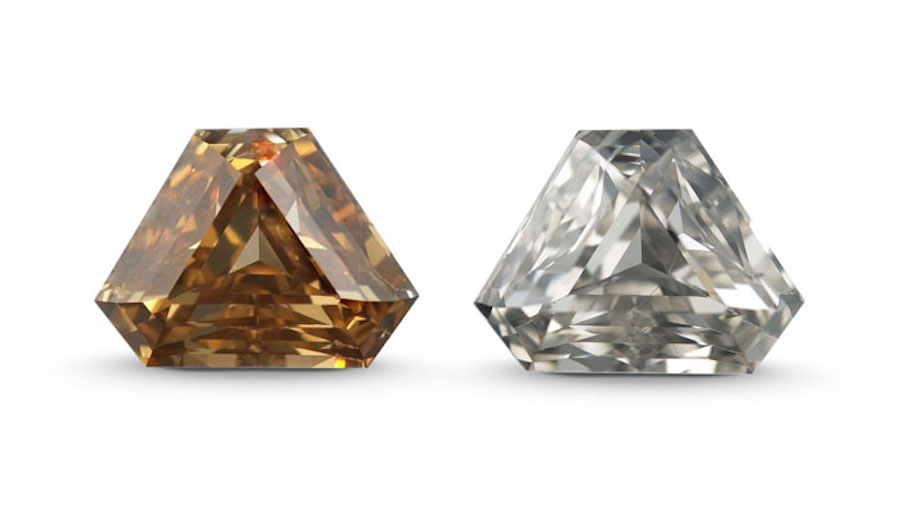
Treatments, also known as enhancements, refer to any process other than cutting and polishing that improves the characteristics and appearance of the color and clarity of natural gemstones. Some of the treatments are permanent, but others are likely to be reversed. Depending on the type and extent of the treatment, the value of the gemstone may be affected. By the law, it is required to fully disclose to the consumer if the gemstones are treated. Please note that treated gemstones, are not to be compared with synthetic gemstones or simulants.
Treated or Enhanced Diamonds
Treated or enhanced diamonds are natural diamonds which have undergone artificially treatments to improve their characteristics and appearance in clarity or color. This involves clarity enhancements (such as laser drilling and fracture filling) and color enhancements (such as HPHT, coating, and irradiation). Because the diamond has been treated, the value is much less than it would be on a natural diamond. Detecting most diamond treatments is a challenge to the entire industry. However, some diamonds treatments may be easier to identify. GIA will issue grading reports for diamonds that have been laser drilled, or HPHT processed, disclosing the presence of treatments on the report. As a further precaution, it will also laser-inscribe the girdles of diamonds it identifies to be color-treated. GIA does not issue grading reports for any diamond that has undergone a treatment process that is considered nonpermanent or unstable, such as coating or fracture filling.
We at Riginov offer our customers only natural diamonds and do not recommend purchasing any treated diamonds.
The most common gemstones treatments are:
Bleaching
Bleaching refers to a chemical used to alter or remove a component or the entire color, of a porous gemstone. The treatment is permanent and practically undetectable, even to the trained eye. Some gemstones are bleached and then dyed. Commonly used for organic gem materials such as pearls, ivory, and coral.
Coating
Coating refers to applying a thin layer of coloring agent like paint to the surface of a gemstone partially or entirely to alter its appearance by modifying the color, luster or brilliance. The treatment is not permanent. Commonly used for diamonds, quartz, beryl, and topaz.
Dyeing
Dyeing refers to introducing a coloring agent into a porous or fractured gemstone to give it a new color, intensify an existing color, or improve color uniformity. Dyes can fade over time or alter, so do not expose to acetone, rubbing alcohol, and prolonged direct sunlight. Dyeing is one of the oldest treatments recorded.
Fracture or Cavity Filling
Refers to the filling of surface-reaching fractures or cavities of a gemstone with colorless solids or liquids such as glass, resin, wax or oil to conceal their visibility and to improve the apparent clarity, stability, or in extreme cases to add to a slight amount of weight to the gemstone. The treatment is not permanent, so avoid high heat, hot water, changes in air pressure and household cleaners, which can potentially alter the filler. Commonly used for diamonds, rubies, emeralds, and sapphires.
Heating
Heating refers to the exposure of a gemstone to high temperatures to alter its color and clarity. Heat-treated gemstones are stable, and the treatment is permanent and usually detectable. This is the most common gemstone treatment, for example, over 95% of all rubies on the market today are heat-treated. Commonly used for amber, amethyst, aquamarine, citrine, ruby, sapphire, tanzanite, topaz, and tourmaline.
High Heat High Temperature (HPHT)
Heating diamonds at high pressures and high temperatures can remove or lessen their brownish coloration permanently so that the diamond becomes colorless. Other types of diamonds may be transformed from brown to yellow, orangy yellow and yellowish-green, or blue. Colored diamonds treated this way are not considered fancy colored diamonds. This is probably the most well-known method to change the color of a diamond. Commonly used only for diamonds.
Impregnation
Refers to the impregnation of the surface of a porous gemstone with a colorless agent such as polymer, wax, or plastic to give it greater durability and improve its appearance. Commonly used for opaque gemstones such as turquoise, lapis lazuli, and jadeite.
Diffusion
Diffusion refers to the penetration of certain elements like beryllium into the atomic lattice of a gemstone during heat treatment, intending to change or accentuate its color. The treatment is permanent. However, the color created through diffusion usually only penetrates a small distance within the gem. Therefore if the gemstone is chipped or re-cut, the less vivid color underneath will be visible. Commonly used for rubies and sapphires.
Irradiation
Irradiation refers to the exposure of a gemstone to an artificial source of radiation to change its color permanently. This is then usually followed by annealing, a heat treatment to further modify the color. Blue topaz is achieved through irradiation combined with heat treatment. Commonly used for sapphires, quartz, and fancy colored diamonds (black, green, blue, yellow, and red).
Laser Drilling
Laser drilling refers to using a very fine laser beam to drill a tiny channel from the surface, through the diamond reaching the dark inclusion buried inside. This is generally followed by the use of a chemical forced into this channel to remove or alter the appearance of the dark inclusion. This treatment is done to enhance the clarity appearance of a diamond. However, there is a debate on that since it still leaves a drill hole and creates yet another inclusion. Most laser drilling is easy to identify with careful inspection of the diamond through magnification. Commonly used only for diamonds.
Oiling
Oiling refers to a filling of surface-reaching cracks or fissures in a gemstone with a colorless oil or resin, wax or other substance except for glass or plastic. The oil smooths the surface and diminishes the visibility of fractures and thus improve transparency in the gemstone. The treatment is usually not permanent, and special care must be taken to avoid ultrasonic cleaning techniques. Commonly used for emeralds.